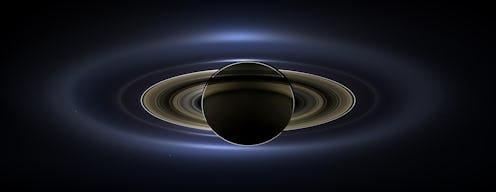News
Could We Live On Saturn's Death Star?
Don't worry about climate change guys. If we destroy this planet, we'll just move to another one! Well, not exactly another planet, but another planet's moon. According to a paper to be published in the prestigious Science journal on Friday, scientists have reason to believe that one of Saturn's "Death Star" moons, Mimas, houses an underground ocean. Either that, or something else strange is going on underneath its cratered surface. And if that something is indeed a body of water, then we may be looking at our Plan B for humanity, in case we fail to address global warming and other environmental issues. And though Mimas might not be nearly as pretty as Earth — a gray, crater-ridden moon doesn't have much on the greens and blues of our planet — we're in no place to be particularly picky.
Scientists first began to suspect that Mimas' icy, rocky exterior didn't tell its whole story when they examined footage of the moon captured by the Cassini spacecraft. Images suggested that Mimas rocked back and forth, much like a pendulum, as it orbited around Saturn. This swinging motion, known as libation, was particularly strong in one specific part of the moon, which suggested to scientists that there is something inside Mimas contributing to its abnormal motion.
Because the moon is an almost perfect sphere, there is little reason that its orbit should be so, for lack of a better word, "wobbly." And after careful consideration, scientists, led by Radwan Tajeddine of Cornell University, developed two possible scenarios that could contribute to this irregularity.
The first option is that Mimas' core is oblong and irregularly shaped, which may have been caused by the gravitational pull of Saturn's famous rings.
The second, more interesting option for us is that the area of the moon particularly affected by libation houses an underground ocean, miles beneath the surface. The movement of the water may contribute to the irregular orbit, and underground oceans have been discovered in other planetary bodies as well. In fact, two of Saturn's other moons, Titan and Enceladus, as well as three of Jupiter's moons are hypothesized to hide subsurface bodies of water. In an email to Reuters, Tajeddine wrote, "If Mimas does have an ocean, this would definitely be another interesting body in the solar system to be added to list of potential ‘life-friendly’ environments."
As interesting as it would be, Tajeddine and his colleagues seem to believe that this is not the more plausible of the two scenarios. Unlike the other moons with suspected oceans, Mimas has never been shown to display any signs of water above ground, which makes the presence of an underground ocean somewhat dubious. In the upcoming article, researchers write, "The ocean hypothesis sounds unlikely because...Mimas’ heavily cratered surface has shown no evidence of liquid water, thermal heating or geological activities." Enceladus, on the other hand, displays surface features that suggest water has shaped some of its landscape.
But Tajeddine also notes that neither of Jupiter's two icy moons, Ganymede and Callisto, display outward signs of water presence, but are both now thought to contain these underground oceans. Of course, there is also the possibility that the libation is caused by a third possibility that Tajeddine's team did not consider.
William McKinnon, a planetary scientist at Washington University in St. Louis, for example, suggested to Science that the unusual movements might not have had anything to do with the insides of Mimas at all. Rather, he said, Mimas may have been struck by a fast-moving comet, which threw its orbit out of sync. And given how cratered Mimas already is, it seems unlikely that scientists would have noticed the existence of yet another comet strike.
Regardless of the reasons behind the orbit, researchers noted in a statement that they were excited about the possibilities that this latest data has provided. Said Tajeddine,
We're very excited about this measurement because it may indicate much about the satellite's insides. Nature is essentially allowing us to do the same thing that a child does when she shakes a wrapped gift in hopes of figuring out what's hidden inside.
While Tajeddine had previously considered Mimas "the most boring satellite," these latest discoveries prove that there are still many things to learn about the world outside our own. In order to solve Mimas' riddle, scientists say that they would either have to fly closer to Mimas to measure its gravitational pull, or take careful temperature readings to look for warmer areas where ice could melt to water. Either way, it will take considerably more time and effort before Tajeddine and his team can determine whether Mimas is a viable alternate environment, and even more time before humans make it out to Saturn. Take care of planet Earth, friends. It's still all we've got.
Images: newscientist, NOVAeducation/Twitter; Getty Images (2)
